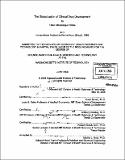| dc.contributor.advisor | Ernst Berndt and Anthony Sinskey. | en_US |
| dc.contributor.author | Thiers, Fabio Albuquerque | en_US |
| dc.contributor.other | Harvard University--MIT Division of Health Sciences and Technology. | en_US |
| dc.date.accessioned | 2007-01-10T16:38:02Z | |
| dc.date.available | 2007-01-10T16:38:02Z | |
| dc.date.copyright | 2006 | en_US |
| dc.date.issued | 2006 | en_US |
| dc.identifier.uri | http://hdl.handle.net/1721.1/35556 | |
| dc.description | Thesis (S.M.)--Harvard-MIT Division of Health Sciences and Technology, 2006. | en_US |
| dc.description | Includes bibliographical references (p. 54-58). | en_US |
| dc.description.abstract | Industry-sponsored clinical research of investigational drugs (also called clinical development) has traditionally been carried out in relatively developed countries in the North American, Western European, and Pacific regions. However, lately it has been widely reported that clinical trials starting now are becoming increasingly diffused globally, with significant growth of activity in so-called emerging economies in Eastern Europe, Latin America, and Southeast Asia. This change in location of clinical development activities has numerous implications for patients, health care providers, pharmaceutical companies, regulatory agencies and governments around the globe. Even though there is much debate about the topic, a public systematic quantitative assessment of the current status of the globalization of clinical drug development phenomenon is lacking. The objective of this thesis research is to provide such objective quantification while addressing some issues that are currently in active discussion. This thesis documents that the participation of emerging countries is still relatively small (13%) and they most commonly participate in very large (involving more than five countries) phase Ilb or III trials. | en_US |
| dc.description.abstract | (cont.) Albeit perceived as small, this participation is growing at a rapid pace (23% average annual growth rate) and the number of clinical sites of global clinical trials located in all emerging countries (11,038) is comparable with the sum of Germany, France, U.K., and Italy (11,061). Eastern European and Latin American countries have the greatest participation in clinical trials among emerging countries, but Southeast Asia is the region that is experiencing fastest growth. Meanwhile, Western Europe has experienced negative average annual growth of -8%, and North America has seemingly been stable. This thesis discusses findings and key drivers behind the globalization process. I also consider the argument that the sustainability of this model will depend on stringent protection of patients in these emerging countries and continued development of these nations, with eventual creation of an attractive market for pharmaceutical products. The extension of this process of globalization of clinical trials, if coupled with substantial improvements in health care delivery and research capacity in these emerging economies, has the potential of revolutionizing medical product development within the next two decades. | en_US |
| dc.description.statementofresponsibility | by Fabio Albuquerque Thiers. | en_US |
| dc.format.extent | 58 p. | en_US |
| dc.format.extent | 3189328 bytes | |
| dc.format.extent | 3189282 bytes | |
| dc.format.mimetype | application/pdf | |
| dc.format.mimetype | application/pdf | |
| dc.language.iso | eng | en_US |
| dc.publisher | Massachusetts Institute of Technology | en_US |
| dc.rights | M.I.T. theses are protected by copyright. They may be viewed from this source for any purpose, but reproduction or distribution in any format is prohibited without written permission. See provided URL for inquiries about permission. | en_US |
| dc.rights.uri | http://dspace.mit.edu/handle/1721.1/7582 | |
| dc.subject | Harvard University--MIT Division of Health Sciences and Technology. | en_US |
| dc.title | The globalization of clinical drug development | en_US |
| dc.type | Thesis | en_US |
| dc.description.degree | S.M. | en_US |
| dc.contributor.department | Harvard University--MIT Division of Health Sciences and Technology | |
| dc.identifier.oclc | 73806473 | en_US |
